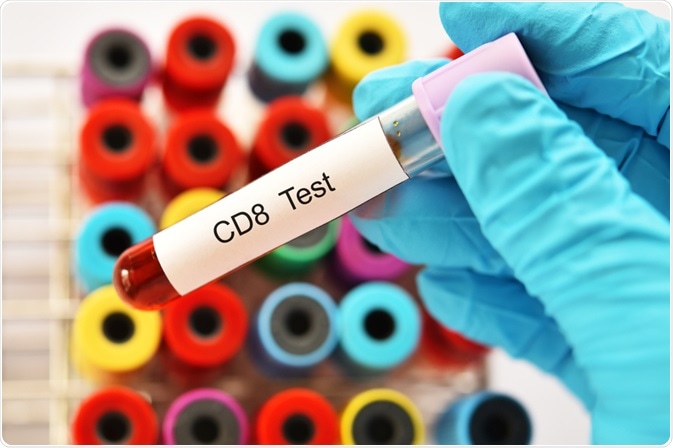A team from the University of Geneva have discovered an antibody that can detect the presence of the mouse CD8β protein by flow cytometry.
 Image Credits: Jarun Ontakrai / Shutterstock.com
Image Credits: Jarun Ontakrai / Shutterstock.com
What is CD8?
CD8 is a membrane-bound glycoprotein complex that is expressed primarily by cytotoxic T lymphocytes. This binds to the major histocompatibility complex (MHC) molecule. The CD8 receptor is composed of two isoforms alpha and beta, each encoded by a different gene. The predominant form of CD8 is comprised of a CD8-α and CD8-β chain, and the resultant heterodimer is positioned on the cell surface.
Identifying T cells using their CD8 receptors
The need to identify T cells via their CD8 receptors is important in the context of mature T-cell neoplasms, the correct diagnosis of such neoplasms is hinged on the identification of immunophenotypically or morphologically abnormal T cells.
However, the issue is complicated by the fact that atypical T-cell subsets cannot be confidently categorized as truly malignant. Some sub-sets of the abnormal T c-cell phenotype may be benign or lack aberrant immunophenotypic aberrations of cytological abnormalities.
Consequently, lab testing of clonality based on immune receptor analysis is crucial. Besides identifying T cells, antibodies against this receptor are important in the removal of these cells in patients who are immunocompromised.
Visualizing and sorting cells using flow cytometry
One way of receptor analysis is achieved through flow cytometry. In this method, the physical characteristics of single particles in a solution are measured as they travel past a beam of light. The light properties scattered from cells are used as the basis of identification.
Labelled antibodies are used in the process of immunophenotyping, the process of studying the protein expressed by cells. Fluorophores are typical labels used in the process and are conjugated to an antibody that recognizes a target feature. Each fluorophore has characteristic peak excitation and emission wavelength which can be visualized
Study design: generating the AJ517 antibody and CD8β protein
The team utilized an AJ517 antibody with the antigen-binding variable portion (scFv) fused to a rabbit IgG constant region (Fc). The sequence of the variable region synthesized corresponded to the sequence of the variable regions of the hybridoma.
Antigen production was achieved by raising a hybridoma against the murine leucocytes. The mice were transfected with the vectors that encoded for the full-length mouse CD8a and CD8β protein. This was necessary to ensure that proper protein dimerization and cell membrane trafficking occurred.
To produce the antigen binding to the CD8β protein, cells were transfected, pelleted and then washed to obtain the antigen. Cells were then incubated with the primary antibody AJ517 for 20 minutes. A washing step was necessary to remove unbound primary antigen.
Following this, cells were incubated with a secondary oat anti-rabbit IgG conjugated to Alexa Fluor 488. A final washing step precluded their resuspension in washing buffer, followed by flow cytometer analysis.
The success of AJ517 antibody receptor binding
The group found that the antibody AJ517 specifically binds to the CD8β protein present at the cell surface of the transfected cells expressing the dimerized CD8a and CD8b. A positive control, cells subject to mock transfection with both components of the CD8 cell membrane glycoprotein.
This study expands the range of antibodies capable of detecting this clinically important protein. The use of antibodies is essential in exerting a range of effects on the T cell-targeted – ranging from the analysis of the mechanism of function to the modulation of their immunological functions.
Source
D’Esposito, A.G et al. (2020) The AJ517 antibody detects the mouse CD8βprotein by flow cytometry. Antibody Reports. Doi: 10.24450/journals/abrep.2020.e114
Further Reading